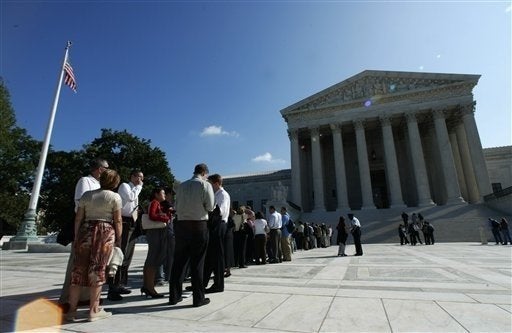
Now that the initial fall-out over last week's Supreme Court's decision in Ricci v. DeStefano has settled and the implications for Judge Sotomayor's confirmation hearings have been discussed and debated, we might take some time to consider the where this decision falls in the longer arc of affirmative action and the Civil Rights act -- 45 years after its passage.
Specifically, two sections of Title VII of the Civil Rights Act of 1964 have long been in tension: Employees are protected from "disparate treatment" -- i.e. intentional actions that result in discriminatory outcomes. But they are also protected from "disparate impact" -- i.e. unintentional conditions, such as a biased test, if those conditions produce discriminatory outcomes. Affirmative action policies rest on the horns of this tension: Institutions -- such as universities or employers -- act intentionally on the basis of race in order to compensate for an implicit disparate impact on racial minorities or other protected groups.
In other words, they are using disparate treatment to fix putative disparate impact. Justice Anthony Kennedy, writing the majority opinion, clarified that such efforts -- like throwing out the test results for the New Haven firefighter promotions -- must be justified by the "strong-basis-in-evidence" standard. In other words, there has to be pretty powerful evidence that the test was unfair. The fact that no blacks made the competitive cut is not evidence in itself. That would be confusing the cart (the promotions) and the horse (the exam).
In light of this, we might reasonably ask ourselves: What would constitute evidence? Until this question is answered, Justice Kennedy's majority opinion gives us little clarity on how to insure equal opportunity in America. Though simpler to administer, "equality of outcome" -- what quotas seek to implement -- has been rejected by U.S. courts and does not sit well with American ideology. So we are left with the tough job of figuring out whether someone's chances -- i.e. opportunities -- have been adversely impacted by their race, rather than whether his/her outcomes were worsened. That's a much taller task.
What's more, the question of evidence of unintentional discrimination is harder to pin down in the case of employment opportunities than it is in the case of education -- and especially hard for jobs like firefighting where outcomes are tough to measure. The difference lies in the fact that college is a preparation for the labor market -- a means to an end, a.k.a. a path to opportunity. We can measure the end results -- how minorities and whites fare once they graduate -- in order to ask whether affirmative action policies are rectifying an inherently unlevel admissions playing field or, rather, putting unqualified minorities in educational environments that they cannot handle at the expense of qualified whites.
For example, in The Shape of the River, authors William G. Bowen and Derek Bok demonstrate that minority students admitted with lower SAT scores than their non-minority counterparts go on to perform equally well as life marches on in a variety of contexts and measures ranging from professional achievement to community service and not as well in others, such as income. In other words, the results are mixed, depending on what you think the purpose of college is.
So if it turns out to be fairly hard to measure disparate impact in college admissions, it's nearly impossible for employment. How would we measure the outcomes -- i.e. the productivity -- of a lieutenant or captain in the New Haven Fire Department? Lives saved or fires prevented? Social cohesion in the firehouse or cleanliness? Money saved or dollars spent? It's impossible, of course, since many of the would-be indicators are in tension with each other.
It would be simpler to scrap our whole approach to discrimination -- written in a bygone era of de jure discrimination -- and start from scratch. Clearly there is a racially disparate impact in New Haven -- but it's probably not on the exam, it's in life: Blacks in the area go to worse schools and come from families that are, on average, much more disadvantaged economically. African Americans and Latinos are much more likely to have one parent at home growing up and are exposed to more dangerous environments. By the time they take the promotion test, this disparate impact is buried under years -- or even generations -- of policies and conditions.
Expecting a single test to compensate for all that is unrealistic -- silly even. This is a symptom of a larger pathology in the American psyche where our deep and abiding belief in meritocracy clashes with our culture of individualism: We expect testing (and schools) to do the work of social policy when it can't really carry that heavy a load. Getting potentially biased questions redacted from an exam by an outside consultant is usually too little, way too late.
So if we want to ensure true equality of opportunity, we need to update our toolbox and focus on the disparate lives of disadvantaged groups -- by race, class, and disability status, just to name a few -- long before kids take the SATs or firefighters take an "externally validated" exam. Until then, Ricci v. De Stefano won't be the last we've heard on the issue of employment discrimination.